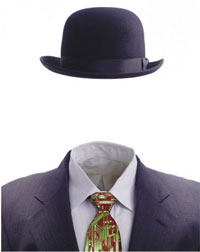
Transparência para PNG no IE6
Na hora de implementar um layout uma das muitas escolhas que fazemos é qual tipo de arquivo de imagens vamos usar. A resposta, é claro, depende do nosso objetivo, mas muitas vezes o formato png é o escolhido. Ele consegue unir a qualidade gráfica do jpg com a transparência com que os gif's da vida nos acostumou.
O problema é que o Internet Explorer 6 não lida bem com esse formato de arquivo e vai substituir a camada transparente por uma horrível camada cinza claro. Vamos ver agora nesse breve tutorial como contornar isso e usar png's transparentes no IE6 em um site em Plone sem maiores problemas. (Thanks WebLion!)
1º - declare no css a seguinte linha da folha de estilo do seu produto:
* html img, div, a, input { behavior: url(&dtml-portal_url;/
iepngfix
.htc); }
Obs: Pode ser necessário incluir algumas classes especificas, como os cantos arredondados dos portles, etc.. Isso depende muito de projeto para projeto.
2º - Na pasta de templates do seu skin crie o arquivo iepngfix.htc.dtml
<dtml-call "REQUEST.RESPONSE.setHeader('Content-Type', 'text/x-component')">
<attach event="onpropertychange" onevent="iePNGFix(0)" />
<script type="text/javascript">
// IE5.5+ PNG Alpha Fix v1.0
// (c) 2004-2008 Angus Turnbull http://www.twinhelix.com
// This is licensed under the GNU LGPL, version 2.1 or later.
// For details, see: http://creativecommons.org/licenses/LGPL/2.1/
// This must be a path to a blank image, relative to the HTML document(s).
// In production use I suggest '/images/blank.gif' or similar. That's all!
if (typeof blankImg == 'undefined') var blankImg = 'blank.gif';
function filt(s, b)
{
var f = 'DXImageTransform.Microsoft.AlphaImageLoader';
var sM = (currentStyle.backgroundRepeat == 'no-repeat') ? 'crop' : 'scale';
s = (s || '').replace(/\(/g, '%28').replace(/\)/g, '%29');
if (s && !(/IMG|INPUT/.test(nodeName) && !b) &&
currentStyle.width == 'auto' && currentStyle.height == 'auto')
{
style.width = offsetWidth + 'px';
style.height = clientHeight + 'px';
if (currentStyle.display == 'inline') style.display = 'inline-block';
}
if (filters[f])
{
filters[f].enabled = s ? true : false;
if (s) with (filters[f]) { src = s }
}
else if (s) style.filter = 'progid:'+f+'(src="'+s+'",sizingMethod="' + sM + '")';
}
function iePNGFix(init)
{
if (!/MSIE (5\.5|6)/.test(navigator.userAgent) || typeof filters == 'unknown') return;
var evt = init ? { propertyName: 'src,background' } : event;
var isSrc = /src/.test(evt.propertyName);
var isBg = /background/.test(evt.propertyName);
var isClass = !init &&
((this.className != this._png_class) && (this.className || this._png_class));
if (!(isSrc || isBg || isClass)) return;
this._png_class = this.className;
var blank = blankImg.match(/([^\/]+)$/)[1];
// Required for Whatever:hover support - erase any set BG if className changes.
if (isClass && ((style.backgroundImage.indexOf('url(') == -1) ||
(style.backgroundImage.indexOf(blank) > -1)))
{
setTimeout(function() { this.style.backgroundImage = '' }, 0);
return;
}
if (isSrc && this.src && /IMG|INPUT/.test(nodeName))
{
if ((/\.png/i).test(src))
{
filt(src, 1);
src = blankImg;
}
else if (src.indexOf(blank) == -1) filt();
}
var bgSrc = currentStyle.backgroundImage || style.backgroundImage;
if ((bgSrc + this.src).indexOf(blank) == -1)
{
var bgPNG = bgSrc.match(/^url[("']+(.*\.png[^\)"']*)[\)"']+[^\)]*$/i);
if (bgPNG)
{
style.backgroundImage = 'url("' + blankImg + '")';
filt(bgPNG[1], 0);
// Unclickable elements inside PNG backgrounds.
var tags = ['a', 'input', 'select', 'textarea', 'iframe', 'object'],
t = tags.length, tFix = [];
while (t--)
{
var elms = all.tags(tags[t]), e = elms.length;
while (e--) tFix.push(elms[e]);
}
var t = tFix.length;
if (t && (/relative|absolute/i).test(currentStyle.position))
alert('IEPNGFix: Children of positioned element are unclickable:\n\n<' +
nodeName + (id && ' id=' + id) + '>');
while (t--)
if (!(/relative|absolute/i).test(tFix[t].currentStyle.position))
tFix[t].style.position = 'relative';
}
else filt();
}
}
iePNGFix(1);
</script>
3º - Crie uma imagem de 1px de largura com fundo transparente chamada blank.gif
Seguindo estes passos você vai criar um script que substitui a área cinza pelo gif transparente, simulando no IE6 os efeitos normais de navegadores mais avançados.
